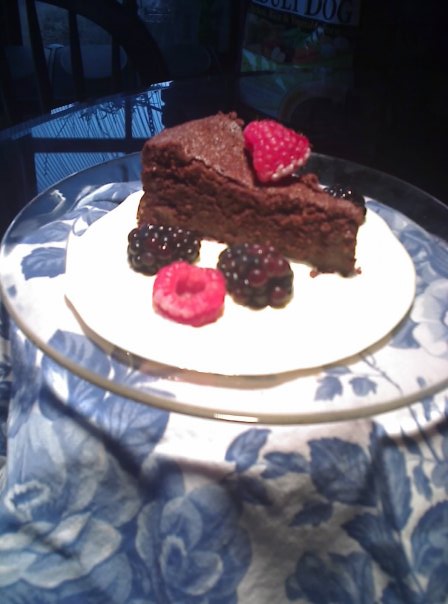Creme Anglaise (the base of vanilla ice cream) is the French translation for custard
sauce. There are two types of custard; cooked (stirred) and baked. The
difference being that ‘baked’ custards contain whole eggs and are
cooked ‘in’ a water bath ‘in’ the oven (think creme brulee). In
contrast, the ‘cooked’ or ‘stirred’ custard sauce
contains only egg yolks and is cooked ‘on’ the stove, oftentimes
‘over’ a water bath. The end result is a nice rich and smooth textured
sauce that can be served, warm or cold, with cakes, pies, puddings, or
fruit and is ideal for plated desserts.
I served this with my Chocolate Cake/Torte and received thumbs up from my
audience – granted, young men love chocolate. They called this “a keeper”.
The standard proportion for creme anglaise is 5 large egg
yolks for every 2 cups of milk. Extra yolks can be added and light
cream (or half and half) can be substituted for the milk to make a
richer sauce. The amount of sugar can vary, depending on sweetness
desired, but the standard proportion is 1/4 cup (50 grams) of
granulated white sugar. Traditionally a vanilla bean or pure vanilla
extract is added to the sauce although other flavored extracts can be
used, as can zests, alcohol, fruit purees, or even melted chocolate.
Now, cooked custards can also be used as a base for other desserts.
If the custard is thickened with starch (flour/cornstarch) it becomes
a pastry cream/creme patisserie and its uses extend to filling tarts,
cakes, cream puffs, and eclairs. Its most famous use is in the
English Trifle. If some of the milk is replaced with heavy cream the
custard sauce becomes rich and smooth and is used as a base for ice
creams. Take this custard one step further and add gelatin and
whipped cream to it and you now have Bavarian Cream.
A commercial custard powder is available that consists of cornstarch
(cornflour) and artificial flavors (and sometimes sugar). It was
invented by Alfred Bird in Birmingham England in 1837. Some people
prefer this sauce because it is much easier to make and they don’t
have to be concerned with the eggs curdling.
Creme Anglaise: Have a fine medium-sized strainer and bowl ready near the stove.
In a stainless steel bowl stir together, using a wooden spoon, the
sugar and yolks until well blended. (Do not let this mixture sit too
long or a film will develop on the yolks.)
In a small saucepan heat the cream and vanilla bean (if using) just to
the boiling point. Remove from heat and whisk a few tablespoons of
the cream into the yolk mixture. Then, gradually add the remaining
cream, whisking constantly.
Pour this mixture into a medium sized saucepan and, over medium heat,
gently heat the mixture to just below the boiling point (170 – 175
degrees F) (77 – 80 degrees C). You will notice that steam will begin
to appear and the mixture will be slightly thicker than heavy cream.
Do not boil or the eggs will curdle. Check to see if it is the right
consistency by holding a wooden spoon sideways that is covered with
the custard and run your finger along the back of the spoon. If the
streak remains without the cream running down through the streak, it
is ready.
Immediately remove from the heat and pour through the strainer,
scraping up any thickened cream that settles on the bottom of the pan.
Remove the vanilla bean and scrape the seeds into the sauce.
Stir until seeds separate. For maximum flavor, return the pod to the sauce until serving time.
(If you are using pure vanilla extract, instead of the vanilla bean, add
it to the cream now.)
The creme anglaise can be refrigerated covered with plastic wrap for a
couple of days. Always make this ahead of time. In fact, I think it is better if you
make it the day ahead.
Note: If sauce was overheated and curdling occurs, pour instantly
into a blender and process until smooth before straining. A stick blender
works well here.
If necessary, add a little heavy cream to the mixture before blending to adjust the
consistency.
Makes about 2 cups (480 ml).
Creme Anglaise:
2 cups (480 ml) light cream or half and half (12 – 18% butterfat)
1 vanilla bean, split lengthwise (can be found specialty food stores)
or 2 teaspoons pure vanilla extract
1/3 cup (66 grams) granulated white sugar
5 large egg yolks

